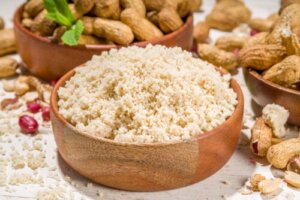Peanut Flour: A Source of Protein for Your Diet


Written and verified by the nutritionist Maria Patricia Pinero Corredor
The peanut is the edible seed of the leguminous plant Arachis hypogaea, whose legume-type fruits contain seeds appreciated in gastronomy. Its protein nutritional value is high, and when it’s transformed into peanut flour, it increases even more.
This flour can be a good option to replace others with lower protein content. Thus, it allows for the enriching of certain preparations and even substituting gluten in the diet. Another advantage is that it contains a good quality fat, comparable to olive oil.
Read on, and you will be delighted to know the applications of peanut flour and how it contributes to enriching your diet with proteins and other high-value nutrients.
What are peanuts?
Peanuts are the sixth richest crop in fat and a major world crop. They’re useful for human consumption as a source of proteins, fats, minerals, and vitamins.
From a botanical perspective, a peanut is not a nut, like walnuts or hazelnuts, but a legume that belongs to the Arachis genus and is native to South America. At the gastronomic level, it’s used as a nut, due to its texture, flavor, and fat content.
Peanuts are very popular as a fried snack, roasted with or without salt, baked, as peanut paste, peanut milk, salty and sweet bars, butter, peanut sauce, and as a cheese substitute.
Peanuts are also consumed as an ingredient in other products and are used raw for the commercial production of oil. Defatted peanut paste is used to make flour to avoid the rancidity of the fat during storage and loss of its sensory characteristics.
We think you may also enjoy reading this article: 2 Ways to Make Chocolate Chip Cookies with Chickpea Flour
How is peanut flour obtained?
In general, traditional peanut flour is obtained from whole peanut meal. After the fat is removed, it’s ground again.
The flour is used in the formulation of pastes, snacks, and beverages. Its emulsifying characteristics make it a favorite in the preparation of curries, crackers, and soup.
It’s also used as a composite flour, forming a mixture with other types of non-wheat flour or when wheat flour needs to be supplemented with protein-rich sources. Other experts have used it to fortify types of bread, increasing the protein value and improving the sensory acceptability of the products.

The nutritional properties of peanut flour
When the fat is removed from peanuts, calories are considerably reduced. This reduction in fat can be up to 30%.
For example, while peanut butter has between 45 to 50% fat, the flour ranges between 10 and 15%. This is also favorable, because the proteins are more concentrated.
Although the amount of fat is reduced, the quality is still good. It’s dominated by oleic fatty acid, a monounsaturated fatty acid characteristic of olive oil.
Some scientific works show the nutritional composition of peanut flour, expressed per 100 grams of product:
- Water content: 4.2%
- Protein: 46 grams
- Fat: 11.5 grams
- Sodium: 0.22 milligrams
- Magnesium: 2.59 milligrams
- Manganese: 13 milligrams
- Potassium: 6.81 milligrams
- Carbohydrates: 22.5 grams
- Fiber: 16 grams
- Oleic acid: 45.2% of total fat
- Linoleic acid: 42,1 % of the total fat
It’s important to notice the high value of protein and fiber, which allows enriching products and other refined flours. In this way, it can improve intestinal transit and avoid constipation.
The minerals found in greater proportion are sodium, magnesium, manganese, and potassium. The manganese in 100 grams of peanut flour manages to cover almost 100% of the daily requirement.
In addition, 45% of all fat is a type of oleic fatty acid, and 42% is a linoleic essential fatty acid. The latter is an omega 6, which due to its pro-inflammatory effect must be balanced with the intake of omega 3.
On the other hand, in terms of vitamin value, niacin is the most important, followed by the B complex vitamins. Vitamin E decreases somewhat when the fat is removed from whole peanuts.
Like this article? You may also like to read: Canary Island Gofio: Nutrition, Benefits and How to Prepare It
The protein in peanut flour
Peanuts have more protein than any other nut, at levels comparable to a serving of beans. In peanut flour, the protein proportion increases when the oil is extracted from the peanuts and can be as high as 50%.
Depending on the protein digestibility corrected amino acid score (PDCAAS), peanut protein is equivalent to that of meat and eggs. It contains all 20 amino acids, but in varying proportions. The PDCAAS value is 0.7 out of 1, while for whole wheat, it’s 0.46.
The amino acid profile of the flour shows that it can be an ingredient for fortification. In addition, the digestibility of its protein is comparable to that of animal protein. The limiting amino acids are lysine, methionine, and threonine.
The star amino acid of peanut protein
Peanuts are considered to be the major source of the amino acid arginine. This is a semi-essential amino acid, as the body manufactures its own supply, but there are times when it needs to be supplemented.
Arginine has several functions, such as strengthening the immune system, regulating hormones and blood sugar, and even promoting male fertility. It also helps detoxify the liver and neutralize the effects of toxic substances in the body.
Moreover, it’s a precursor of nitric oxide, which helps the arteries relax and improves blood flow and the healing time of damaged tissues.
The benefits of peanut flour
The benefits of peanut flour are the same as those of whole peanuts, only the energy and vitamin E values are somewhat lower.
It’s a source of antioxidants
Peanuts and peanut flour contain a good amount of antioxidants, including resveratrol and flavonoids. The former is as good an antioxidant as the one coming from purple grapes. Therefore, peanut flour has protective functions against heart disease, neurodegenerative diseases, and systemic inflammation.
Flavonoids are a type of polyphenols, such as coumaric acid, which also protect against heart disease and are preventive against malignant transformations of cells. These compounds are also found in wine, apples, and green tea.

It may improve your risk of coronary heart disease
The fat left in peanut flour is predominantly monounsaturated, which lowers total and LDL cholesterol, as well as maintains HDL or good cholesterol.
The benefits of peanut fat are comparable to those of olive oil. Studies show a relationship between these monounsaturated fats and a reduction in the risk of coronary heart disease.
It may prevent neurodegenerative diseases
Peanut flour has a high niacin content and maintains acceptable vitamin E values, which protect against Alzheimer’s and age-related cognitive decline.
It can helps you control your weight
It has been observed that peanuts in any form do not lead to weight gain. In addition, diets that incorporate it are more acceptable.
How to take better advantage of the protein in peanut flour?
The high concentration of protein contained in peanut flour can be used by adding three teaspoons or 15 grams to different preparations during the day. This amount provides 7 grams of protein of acceptable digestibility and a good amino acid profile.
It’s recommended to consult a nutritionist about your protein requirements per day.
You can add the flour directly to yogurt or a vegetable smoothie, dissolve in a glass of oatmeal with milk or almond milk, or mix it with other cereal flours for baking or add it sauces, creams, or homemade energy bars.
All cited sources were thoroughly reviewed by our team to ensure their quality, reliability, currency, and validity. The bibliography of this article was considered reliable and of academic or scientific accuracy.
- Aditya U. Joshi, Changqi Liu, Shridhar K. Sathe. Functional properties of select seed flours,. LWT – Food Science and Technology, Volume 60, Issue 1, 2015, Pages 325-331, ISSN 0023-6438,https://doi.org/10.1016/j.lwt.2014.08.038. (https://www.sciencedirect.com/science/article/pii/S0023643814005465)
- L H McKee , T A Latner. Underutilized sources of dietary fiber: a review. Plant Foods Hum Nutr. 2000;55(4):285-304. doi: 10.1023/a:1008144310986.
- Yadav, D.N., Thakur, N., Sunooj K.V. and Singh, K.K. Effect of de-oiled peanut meal flour (DPMF) on the textural, organoleptic and physico chemical properties of bread. International Food Research Journal 20(3): 1307-1312 (2013). Disponible en: http://www.ifrj.upm.edu.my/20%20(03)%202013/40%20IFRJ%2020%20(03)%202013%20Thakur%20(374).pdf
- Diana O. Labuckas Alicia L. Lamarque Damián Maestri. Harina de maní parcialmente deslipidizada: un ingrediente funcional para mejorar el valor nutritivo de productos de panificación. Rev Chil Nutr Vol. 43, Nº4, 2016. Disponible en: https://www.scielo.cl/pdf/rchnut/v43n4/art07.pdf
- FAO/WHO/UNU (2002) Protein and Amino Acid Requirements in Human Nutrition. In: Report of a Joint FAO/WHO/UNU Expert Consultation, World Health Org Tech Report No.935 . Disponible en: https://pubmed.ncbi.nlm.nih.gov/18330140/
- United States Department of Agriculture (USDA) (2014): http://www.nal.usda.gov/fnic/foodcomp/search/. Accessed 21 Aug 2014
- Yu JM, Ahmedna M, Goktepe I, Dai J. Peanut skin procyanidins : composition and antioxidant activities as affected by processing. J Food Compos Anal. 2006;19:364–371. doi: 10.1016/j.jfca.2005.08.003.
- Pelkman CL. Effects of moderate-fat (from monounsaturated fat) and low-fat weight-loss diets on the serum lipid profile in overweight and obese men and women. Am J Clin Nutr. 2004;79(2):204–212. Disponible en: https://pubmed.ncbi.nlm.nih.gov/14749224
- Matilsky DK, Ndekha M, Manary MJ (2009) Supplementary feeding with fortified spreads results in higher recovery rates than with a corn/soy blend in moderately wasted children. J Nutr 139(4):773–8. Disponible en: https://pubmed.ncbi.nlm.nih.gov/19225128
- Morris MC. Dietary niacin and the risk of incident alzheimer’s disease and of cognitive decline. J Neurol Neurosurg Psychiatry. 2004;75(8):1093–1099. doi: 10.1136/jnnp.2003.025858.
- Mattes RD, Kris-Etherton PM, Foster GD. Impact of peanuts and tree nuts on body weight and healthy weight loss in adults. J Nutr. 2008;138(9):1741S–1745S.Disponible en: https://pubmed.ncbi.nlm.nih.gov/18716179
- Francisco ML, Resurreccion AV. Functional components in peanuts. Crit Rev Food Sci Nutr. 2008;48(8):715–746. doi: 10.1080/10408390701640718. https://pubmed.ncbi.nlm.nih.gov/18756396
This text is provided for informational purposes only and does not replace consultation with a professional. If in doubt, consult your specialist.








